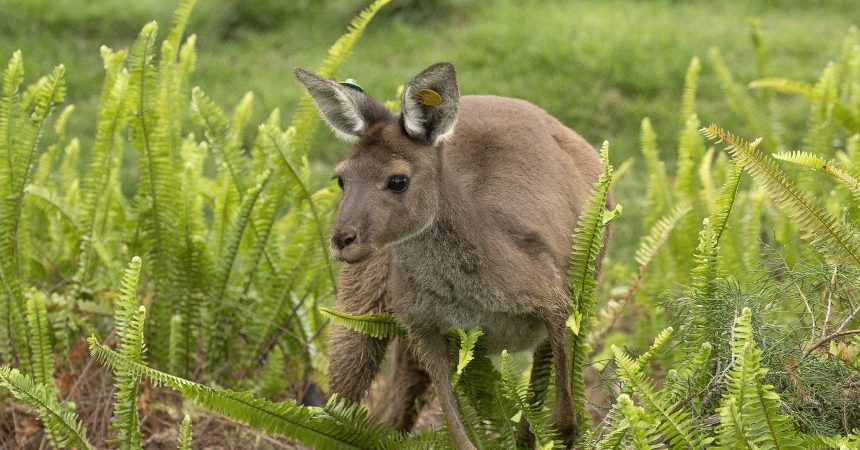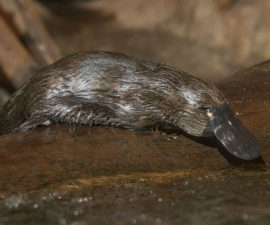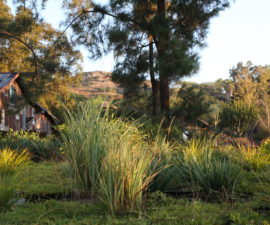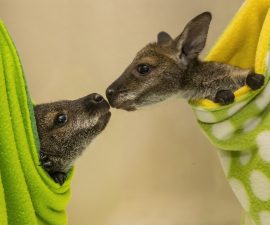The San Diego Zoo Safari Park opened its all-new Walkabout Australia habitat earlier today (Friday, May 25, 2018) with an opening ceremony featuring ambassador animals, dancers and more. Guests visiting the new exhibit were excited to be among the first to experience the main feature of the immersive habitat – a walk-through kangaroo and wallaby exhibit.
“Australia is an extraordinary place, and we are thrilled to provide a snapshot of some of the wonders from Down Under at the all-new Walkabout Australia experience at the Safari Park,” said Lisa Peterson, director, San Diego Zoo Safari Park. “I think what is amazing about Walkabout Australia have used a thematic approach to provide our guests with the ability to see animals in an authentic and immersive environment. They can walk around and see the kangaroo, wallaby and birds in a way they might be able to see them if they could join them in nature. Not only does Walkabout Australia allow us to connect people to Australia’s fascinating wildlife, but it also adds another dimension to San Diego Zoo Global’s efforts to save endangered species, such as the Matschie’s tree kangaroo.”
The Safari Park is known for its expansive habitats featuring African and Asian species, but now it offers a view into the Land Down Under, featuring Australia’s interesting and unique species. Walkabout Australia takes guests through four different types of Australian habitats: grassland, rain forest, wetlands and desert. Featured animals include western gray kangaroos, red-necked wallabies, brush turkeys, radjah shelducks, freckled ducks, magpie geese, double-wattled cassowaries and Matschie’s tree kangaroos.
During a visit, guests also may come nose-to-nose with animals like a wombat, kookaburra, echidna, blue-tongued skink, woma, rose-breasted cockatoo or sugar glider. Accompanied by their keepers, these extraordinary animal ambassadors will be available for up-close encounters several times throughout the day.
Walkabout Australia represents Australia’s rural landscapes and the animals, plants and signs of human habitation encountered along backcountry roads. The 3.6-acre Walkabout Australia cost $17.4 million to build, and is located at the base of the trail to Condor Ridge, adjacent to Tull Family Tiger Trail.
After strolling along a country road among Australian bottlebrush and eucalyptus trees, guests come upon a tumbledown stone house that welcomes them to the grassland. A pathway with no barriers leads guests through an expansive meadow, home to a large group of western gray kangaroos, red-necked wallabies and magpie geese. While guests are asked to be respectful of the animals and to stay on the pathway, the kangaroos and wallabies are welcome to get quite close to visitors, especially if they are feeling inquisitive! This unique opportunity is similar to experiences offered by zoos in Australia, which are a key part of their work to engage local communities in species preservation.
In this era of changing climate conditions, Australia—like California—is experiencing longer and more widespread periods of drought, along with an increase in wildfires. As a result, water is a more precious resource than ever before. Walkabout Australia explores the vital connection between water and the animals and people that depend on it. A stream runs through the grassland area, pooling in a pond—called a billabong by Australians. Its source is a larger wetland pond, where guests will see waterfowl like radjah shelducks and freckled ducks.
A water conservation tank, like one that might be used by Australian farmers or ranchers, demonstrates how collecting water during the rains can be a valuable resource during dry times, and provides suggestions for how to collect and save water at your own home.
The path then leads to Walkabout Australia’s central gathering place—the Zuest (pronounced “Zest”) Station. The Zuest Station is a rustic building representing the wool shearing sheds found on Australia’s many sheep ranches, which are called “stations.” Here, you can stop for a bite to eat and a cool drink, then look around the themed building to learn about the various techniques and traditions of sheep ranching and wool production practiced in Australia for more than 200 years.
On the way into Zuest Station and from a floor-to-ceiling glass window inside the building, guests can view Australia’s rain forest habitat and the Matschie’s tree kangaroo. These endangered marsupials are native to mountainous forests and are part of a Species Survival Plan breeding program at the San Diego Zoo Safari Park, designed to help save their species from the brink of extinction.
Wandering outside Zuest Station, farther into a rain forest habitat, visitors will see the double-wattled cassowary. At 5 feet tall and weighing 130 pounds, this prehistoric-looking bird is hard to miss as it rustles through the brush. Cassowaries are listed as a species of Least Concern on the International Union for Conservation of Nature Red List of Threatened Species, however most tallies put the number of cassowaries remaining in Australia around 1,500 to 2,000. This flightless bird will also be part of a breeding program at the Safari Park, to help build a healthy assurance population.
Australia’s interior and western deserts are legendary for their hot, dry, inhospitable conditions. To experience a bit of this environment, a bridge from Zuest Station leads guests to enormous, rounded rocks similar to those found in Australia, called Devil’s Marbles. From here, Walkabout Australia has opened up new routes to take guests to World Gardens or to Condor Ridge, making it easier than ever to explore all the Safari Park has to offer.
For Walkabout Australia guests who want to upgrade their experience, the Roos & Mates Behind-the-Scenes Safari offers an Aussie-style stroll with a knowledgeable guide around the new habitat. Participants will be able to explore keeper-only areas and get up close to some of the amazing Australian species residing at Walkabout Australia. For more information or to make reservations, visit sdzsafaripark.org/safari/behind-scenes-safari.
The Walkabout Australia website offers more information about the animals and plants that call Walkabout Australia home, and provides fun “Rooisms”—like “Don’t Worry, Be Hoppy”—to share on social media. Online visitors tosdzsafaripark.org/walkabout can take a quick quiz to see which Aussie animal they are like, with participants automatically entered to win a Roos & Mates Behind-the-Scenes Safari for two. Visitors also may share their Walkabout experience on Instagram with #WalkaboutAustralia, and be entered to win a Roos & Mates Behind-the-Scenes Safari for four.
Also, to celebrate the new Walkabout Australia experience, the Safari Park has launched a unique augmented reality (AR) smartphone app called Danceabout Australia. The immersive app is jam-packed with cutting-edge technology and Aussie fun for the whole family. Users can transform the world around them into an outback disco—complete with dancing kangaroos, beautiful stylized environmental elements and hopping dance tracks. Users appear in the resulting videos, dancing with kangaroos—and they can then share their dance parties with their friends. The app is available for download here: https://itunes.apple.com/us/app/danceabout-australia/id1368633786?mt=8.
Walkabout Australia is included with Safari Park admission and membership.





